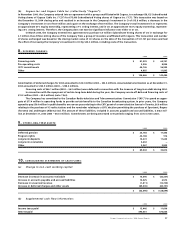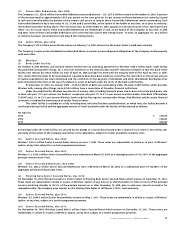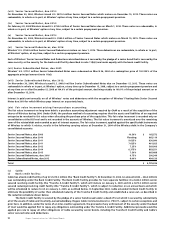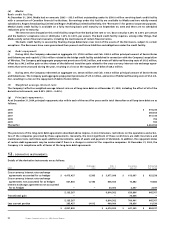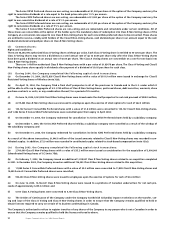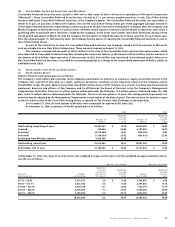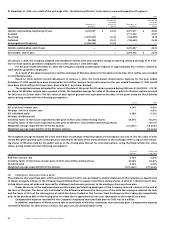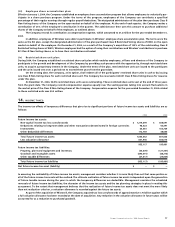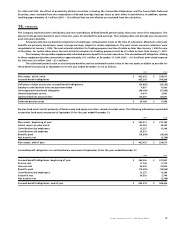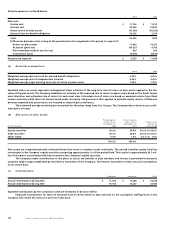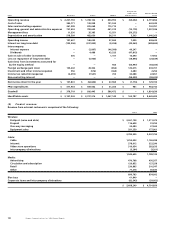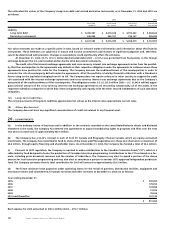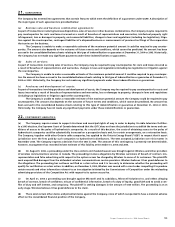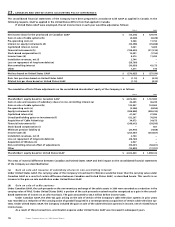Rogers 2004 Annual Report Download - page 99
Download and view the complete annual report
Please find page 99 of the 2004 Rogers annual report below. You can navigate through the pages in the report by either clicking on the pages listed below, or by using the keyword search tool below to find specific information within the annual report.
97
Rogers Communications Inc. 2004 Annual Report
(iii) Employee share accumulation plan:
Effective January 1, 2004, the Company established an employee share accumulation program that allows employees to voluntarily par-
ticipate in a share purchase program. Under the terms of the program, employees of the Company can contribute a specified
percentage of their regular earnings through regular payroll deductions. The designated administrator of the plan then purchases Class B
Non-Voting shares of the Company on the open market on behalf of the employee. At the end of each quarter, the Company makes a
contribution of 25% of the employee’s contribution in the quarter. The administrator then uses this amount to purchase additional
shares of the Company on behalf of the employee, as outlined above.
The Company records its contribution as compensation expense, which amounted to $1.2 million for the year ended December 31,
2004.
In addition, employees of Wireless were able to participate in Wireless’ employee share accumulation plan. The terms were the
same as the RCI plan, except the designated administrator of the plan purchased Class B Restricted Voting shares of RWCI on the open
market on behalf of the employee. On December 31, 2004, as a result of the Company’s acquisition of 100% of the outstanding Class B
Restricted Voting shares of RWCI, Wireless employees had the option of using their contributions and Wireless’ contributions to purchase
RCI Class B Non-Voting shares, or to have their contributions refunded.
(iv) Restricted share unit plan:
During 2004, the Company established a restricted share unit plan which enables employees, officers and directors of the Company to
participate in the growth and development of the Company by providing such persons with the opportunity, through restricted share
units, to acquire a proprietary interest in the Company. Under the terms of the plan, restricted share units are issued to the participant
and the units issued vest over a period not to exceed three years from the grant date.
On the vesting date, the Company, at its option, shall redeem all of the participants’ restricted share units in cash or by issuing
one Class B Non-Voting share for each restricted share unit. The Company has reserved 2,344,591 Class B Non-Voting shares for issuance
under this plan.
At December 31, 2004, 50,916 restricted share units were outstanding. These restricted share units vest at the end of three years
from the grant date. The Company records compensation expense equally over the vesting period, taking into account fluctuations in
the market price of the Class B Non-Voting shares of the Company. Compensation expense for the year ended December 31, 2004 related
to these restricted units was $0.3 million.
14. INCOME TAXES:
The income tax effects of temporary differences that give rise to significant portions of future income tax assets and liabilities are as
follows:
2004 2003
Future income tax assets:
Non-capital income tax loss carryforwards $ 1,219,699 $ 608,691
Deductions relating to long-term debt and other transactions denominated in foreign currencies 98,523 50,391
Investments 64,081 103,769
Other deductible differences 172,759 38,655
Total future income tax assets 1,555,062 801,506
Less valuation allowance 601,945 606,015
953,117 195,491
Future income tax liabilities:
Property, plant and equipment and inventory (35,309) (121,351)
Goodwill and intangible assets (890,491) (48,276)
Other taxable differences (27,317) (25,864)
Total future income tax liabilities (953,117) (195,491)
Net future income tax asset (liability) $ – $ –
In assessing the realizability of future income tax assets, management considers whether it is more likely than not that some portion or
all of the future income tax assets will be realized. The ultimate realization of future income tax assets is dependent upon the generation
of future taxable income during the years in which the temporary differences are deductible. Management considers the scheduled
reversals of future income tax liabilities, the character of the income tax assets and the tax planning strategies in place in making this
assessment. To the extent that management believes that the realization of future income tax assets does not meet the more likely
than not realization criterion, a valuation allowance is recorded against the future tax assets.
As part of the acquisition of Microcell, the Company acquired tax loss carryforwards of approximately $1.75 billion against which
a full valuation allowance has been recorded at the date of acquisition. Any reduction in the valuation allowance in future years will be
accounted for as a reduction to purchased goodwill.


